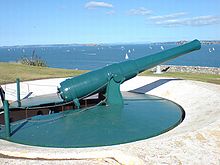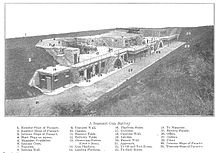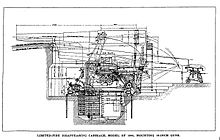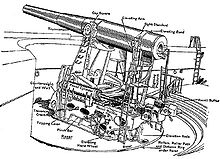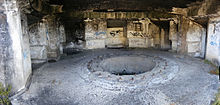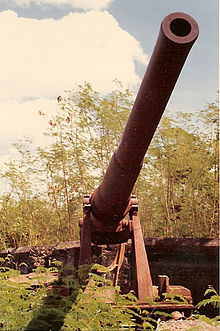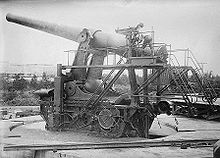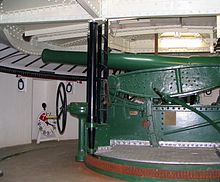- Disappearing gun
-
A disappearing gun (often called a disappearing carriage) is a type of heavy (mainly coastal) artillery for which the gun carriage enabled the gun to rotate backwards and down into a pit protected by a wall (the parapet) or a bunker after it was fired. This retraction lowered the gun from view by the enemy while it was being reloaded.
It also made reloading easier, since it lowered the breech to a level just above the loading platform, and shells could be rolled right up to the open breech for loading and ramming. Although it had these advantages, the disappearing carriage was also a complicated mechanism. In the U.S., disappearing carriages were mostly withdrawn from active service by the early 1920s.
The disappearing gun was usually moved down behind the parapet or into its protective housing by the force of its own recoil, which (on many models) lifted up a very heavy counterweight. Before firing, the crew tripped a catch on the counterweight, causing it to fall into a well at the center of the gun position and move the gun back up "into battery" (firing position).
Some disappearing guns also used compressed air,[1] while a few were built to be raised by steam.[2]
Contents
Advantages
The disappearing carriage had several principal advantages:
- It afforded the gun crew protection from direct fire by raising the gun over the parapet (or wall in front of the gun) only when it was to be fired, otherwise leaving it at a lower level, where it was also able to be loaded easily.
- With its guns in a retracted position (down behind the parapet), the battery was much harder to spot from the sea, making it a much harder target for attacking ships. Flat trajectory fire tended simply to fly over the battery, without damaging it.
- Interposing of a moving fulcrum between the gun and its platform lessened the strain on the latter and allowed it to be of lighter construction while limiting recoil travel.
- Simple, well protected earthen and masonry gun pits were much more economical to construct than the previous practice of constructing the standing heavy walls and fortified casemates of a more traditional gun emplacement.
- The entire battery could be hidden from view when not in use, unlike a traditional fort, enabling ambuscade fire.
Disadvantages
The disappearing gun had several drawbacks as well:
- The carriage design restricted maximum elevation to under 20 degrees and thus lacked the necessary range to match newer naval guns entering service during the early part of the 20th century.[3] The additional elevation gained by mounting the same gun on a later non-disappearing carriage increased their range.[4][citation needed]
- The time taken for the gun to swing up and down and be reloaded slowed the rate of fire. Surviving records indicate a rate of fire of 1 round per 1 to 2 minutes for an 8-inch (20 cm) gun, significantly slower than less complicated guns.[1]
- The improvement in the speed of warships demanded an increased rate of firing. The disappearing gun was at a disadvantage compared with a gun that stayed in position as one could not aim or reposition a disappearing gun while it was in the lowered position. The gunner still had to climb atop the weapon via an elevated platform to sight and lay the weapon after it was returned to firing position.[3]
- Their relative size and complexity also made them expensive compared with non-disappearing mounts.[1]
History
Disappearing guns as a functioning concept were invented in the 1860s by Captain (later Sir) Alexander Moncrieff, who built on his observations in the Crimean War to improve on existing designs for a gun carriage capable of rising over a parapet before being reloaded from behind cover. His key innovation was a counterweight system that raised the gun as well as controlled the recoil. Moncrieff promoted his system as an inexpensive and quickly constructed alternative to a more traditional gun emplacement.[5]
Buffington and Crozier further refined the concept in the late 1880s by incorporating hydro-pneumatic recoil control to assist the counterweight action. The Buffington–Crozier Disappearing Carriage (1893) represented the zenith of disappearing gun carriages,[3] and guns of up to 16-inch size were eventually mounted on such carriages. Disappearing guns were highly popular for a while in the British Empire, the United States and other countries.
However, in the 1890s, a series of Royal Navy/New Zealand Division of the Royal Navy trials carried out in New Zealand (where numerous disappearing guns had been bought and installed during the Russian Scares), revealed the virtual impossibility of a small shore installation being hit by a warship, except by chance.[1] Others dispute that the advantages were so limited, and point to the efficiency of such artillery in for example, the Battle of Port Arthur.[citation needed] In any case, with their protective benefits thus cast into doubt, no further production of the expensive gun carriages was undertaken in New Zealand.
Though effective against ships, the guns turned out to be vulnerable to aerial attack. After World War I batteries of disappearing guns were usually casemated for protection or covered with camouflage for concealment.[6] By 1912, the guns were declared obsolete in the British Army, with only some other countries, particularly the United States, still producing them up to World War I[1] and keeping them active through to the end of World War II.[3]
Other applications
Gun lift battery
One unique and even more complex type of disappearing gun was Battery Potter at Fort Hancock, Sandy Hook, New Jersey. Built in 1892, the Battery covered the approaches to New York harbor. Instead of using recoil from the gun to lower the weapon, two 12-inch barbette carriages were placed on individual hydraulic elevators that would raise the 110-ton carriage and gun 14 feet to enable it fire over a parapet wall. After firing, the gun was lowered for reloading using hydraulic ramrods and a shell hoist. While the operation of the battery was slow, taking 3 minutes per shot, its design allowed an unlimited field of fire.[citation needed]
Battery Potter required a huge amount of machinery to operate the gun lifts, including boilers, steam pressure pumps and two accumulators. Due to the inability to generate steam quickly, Potter's boilers were run nonstop during its 14 year life, creating a significant operating cost. After the proving of the Buffington Crozier carriage, the United States Army abandoned plans to build several additional gun lift batteries.[citation needed]
At least once, the concept was also attempted for conversion to a naval use. HMS Temeraire was completed in 1877 with two disappearing gun turrets sinking down into barbette-structures (basically circular metal protective walls over which the gun fired when elevated). This was to combine the ability of the early pivot guns to swivel with the protection of more classical fixed naval guns. However, the design was not successful and apparently never repeated. It is thought that both harsh saltwater environment and the constant swaying and rolling of a ship at sea were to blame for problems with the complex mechanism.[3] In any case, heavy gun turrets soon afterwards entered naval service, making the idea moot.
See also
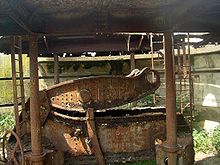 The mount for an 8-inch (20 cm) disappearing gun at South Channel Fort showing the hinged retraction mechanism, Victoria, Australia.
The mount for an 8-inch (20 cm) disappearing gun at South Channel Fort showing the hinged retraction mechanism, Victoria, Australia.
- Coastal artillery
- Seacoast defense in the United States
- Specific installations
- Australia
- Ben Buckler Gun Battery, Bondi, New South Wales
- Flagstaff Hill Fort, Wollongong, New South Wales
- Fort Queenscliff, Port Phillip, Victoria, with a recovered gun from South Channel Fort
- Fort Nepean, Port Phillip, Victoria
- Fort Scratchley, Newcastle, New South Wales
- Henry Head Battery, Sydney, New South Wales
- Steel Point Battery, Vaucluse, Sydney, New South Wales
- Signal Hill Battery, Watsons Bay, Sydney, New South Wales
- South Channel Fort, Port Phillip, Victoria
- Canada
- New Zealand (Armstrong Disappearing Guns)
- Fort Jervois (Lyttelton), one mostly intact BL 6-inch Mk V and one working-order BL 8-inch gun
- North Head (North Shore, Auckland), one remaining gun barrel with mostly intact carriage
- Taiaroa Head (Dunedin) one restored BL 6-inch Mk V
- Philippines
- Fort Mills, Corregidor Island, Manila Bay, Luzon [7]
- Fort Wint, Grande Island, Subic Bay, Luzon
- South Africa 9.2 inch disappearing gun in Fort Wynyard, Cape Town. Visible in Google Earth at coordinates 33° 54.136'S 18° 24.807'E.
- Thailand
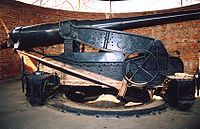

Armstrong 6-inch breechloading disappearing gun of the 1880s at the Chulachomklao fort, Samut Prakan, Thailand - Phra Chulachomklao Fort, Bangkok, seven Armstrong BL 6 inch guns on hydropneumatic disappearing carriages, all in working condition[8]
- United Kingdom
- Flat Holm, Bristol Channel, Wales
- Fort Cumberland, Portsmouth, England
- Crownhill Fort, Plymouth, England
- United States
- Battery Chamberlin, Presidio of San Francisco. Only Buffington-Crozier disappearing carriage still operating.
- Battery Potter, Fort Hancock, Sandy Hook, New Jersey. This is only remaining steam hydraulic battery.
- Fort Casey, Washington
- Fort Hunt, Virginia
- Australia
References
- ^ a b c d e Disappearing Guns (from the Royal New Zealand Artillery Old Comrades Association)
- ^ The Defenses of Sandy Hook (from a Sandy Hook, Gateway National Recreation Area, U.S. National Park Service information pamphlet. Accessed 2008-02-22.)
- ^ a b c d e The Disappearing Gun (from the 'navyandmarine.org' website, with further references. Accessed 2008-02-22.)
- ^ The Six Inch Shield Gun (from a private website. Accessed 2009-02-28.)
- ^ "Moncrieff's method of mounting guns with counterweights, of using them in gun-pits, and of laying them with reflecting sights : a paper read at the Royal United Service Institution (1866)" (from archive.org. Accessed 2009-06-25.)
- ^ "Fort Winfield Scott: Battery Lowell Chamberlin". California State Military Museum. http://www.militarymuseum.org/BtyChamberlin.html. Retrieved 2007-03-30.
- ^ American Seacoast Artillery in the Philippines (12-inch, 10-inch and 6-inch) (from the Coast Defense Study Group website. Accessed 2008-11-14.)
- ^ D. Quarmby, Casemate (Fortress Study Group), 84, 2009, pp17-18
- Hogg, I.V., "The Rise and Fall of the Disappearing Carriage", Fort (Fortress Study Group), (6), 1978
Categories:- Artillery by type
- Military equipment of the Industrial era
- Warfare of the Industrial era
- Military history of the United Kingdom
- Military history of New Zealand
- Coastal artillery
Wikimedia Foundation. 2010.

